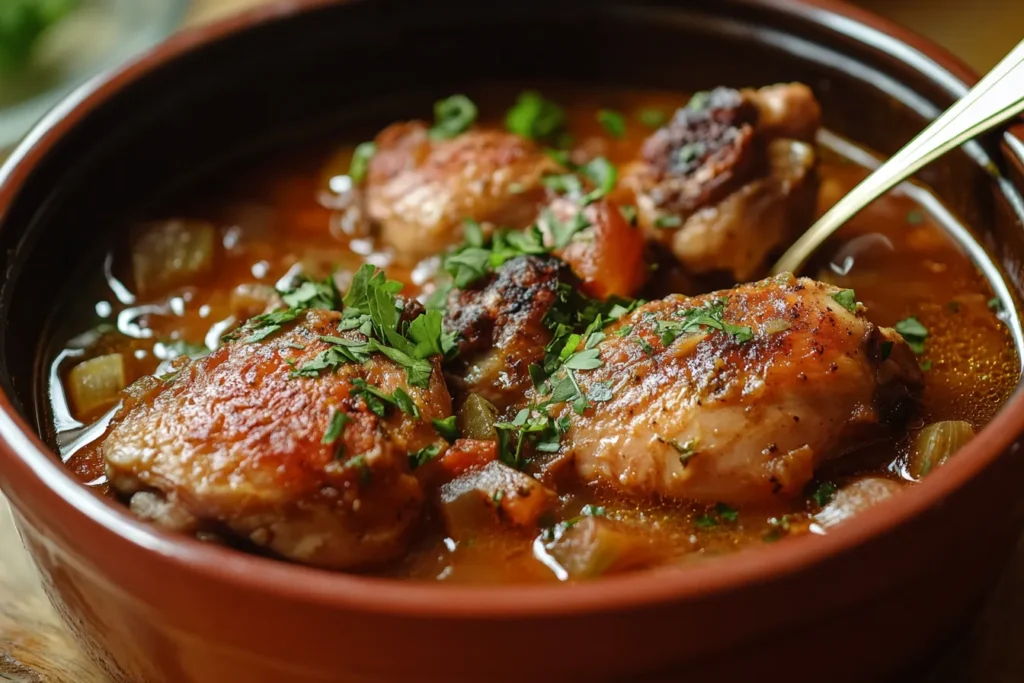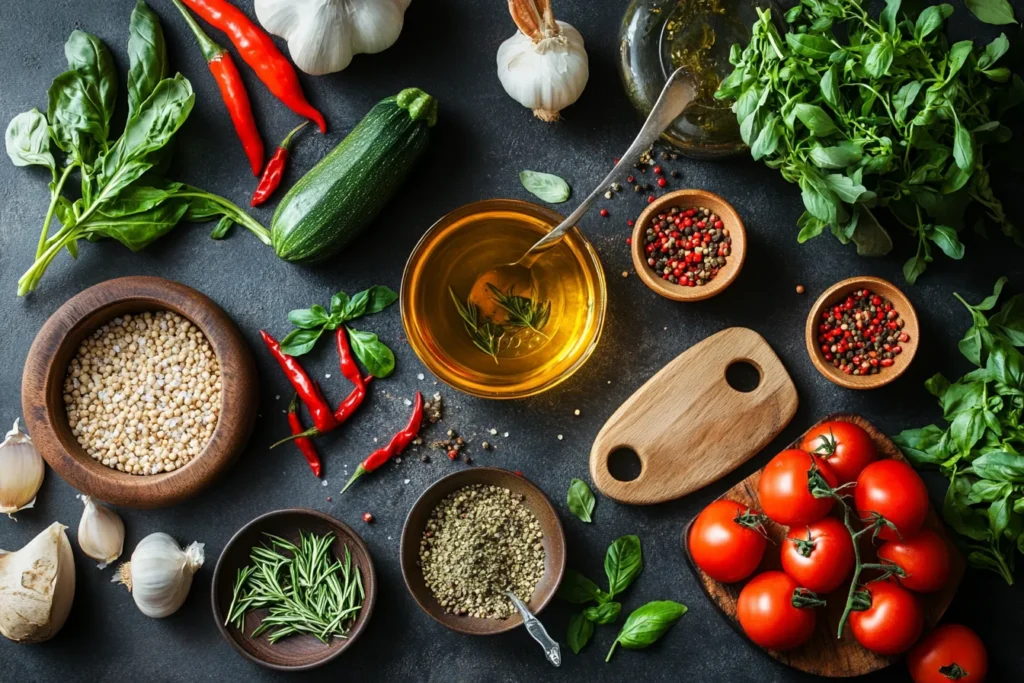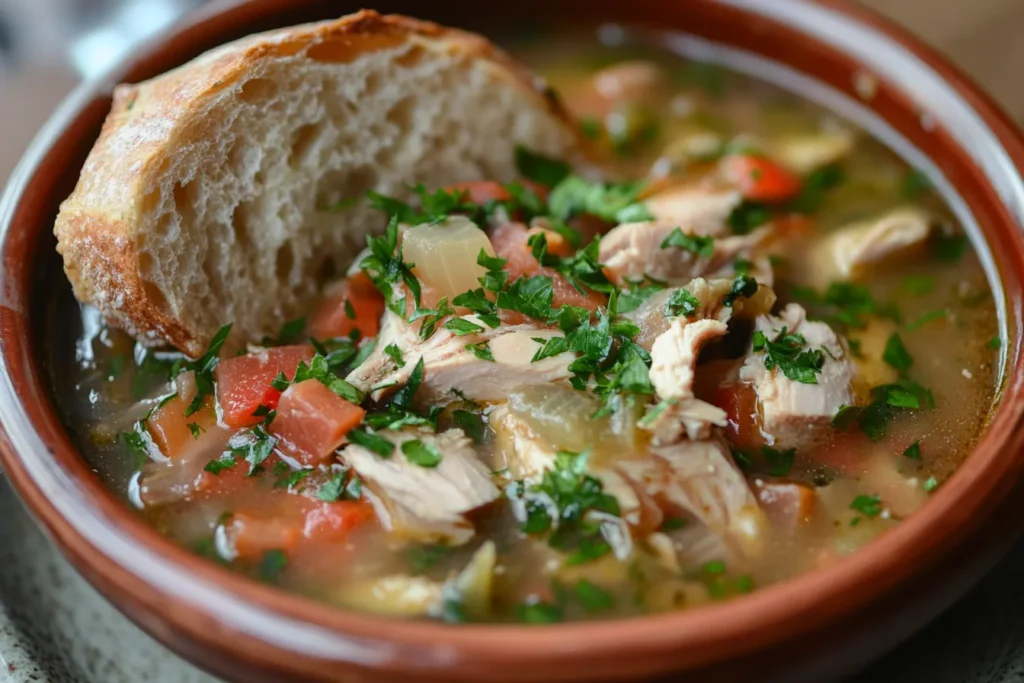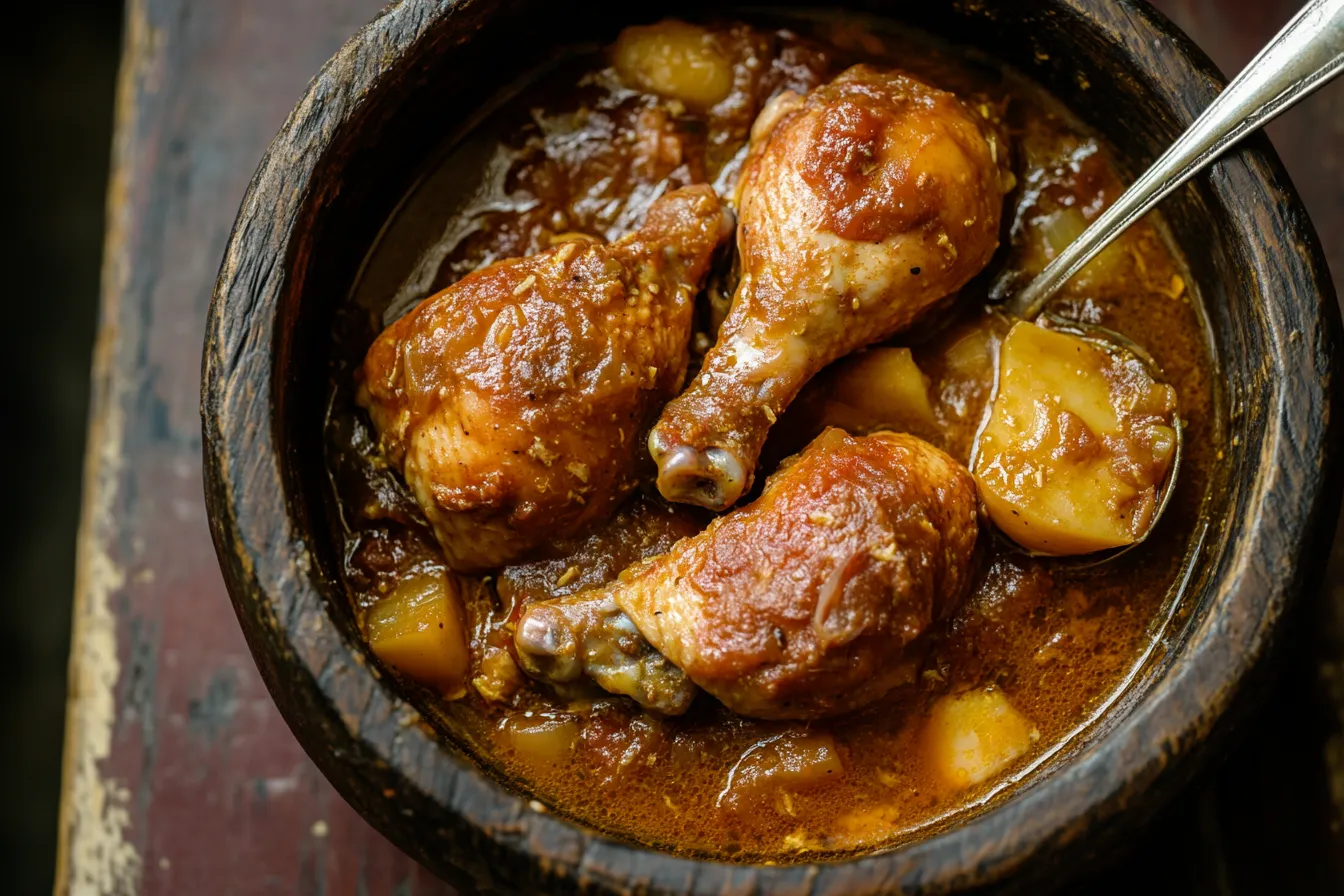Table of Contents
Hey there, food adventurers! 👋 Ever feel like you need a big, warm hug in a bowl? Well, let me tell you, there’s a dish out there that’s basically the edible equivalent of that feeling: chicken stew. It’s not just food; it’s comfort, it’s tradition, and it’s surprisingly easy to make absolutely mouthwatering. Whether you’re a seasoned chef or just starting your culinary journey, this guide is your roadmap to creating the perfect pot of chicken stew. Get ready to learn all the ins and outs, from the basic recipe to tackling those pesky stew-related problems we’ve all faced. Let’s dive in!
Why Chicken Stew is the Soul Food We All Crave 🥰
Think about it for a second. What comes to mind when you hear “chicken stew”? For me, it’s cozy evenings by the fireplace, the comforting aroma filling the kitchen, and that feeling of pure, unadulterated satisfaction after the first spoonful. It’s the kind of dish that transcends trends and generations, a true classic for a reason.
A Warm Hug in a Bowl: The Timeless Appeal of Chicken Stew
Seriously, is there anything more comforting than a hearty bowl of chicken stew on a chilly day? It’s like wrapping yourself in a warm blanket, but you can eat it! This isn’t some fancy, complicated dish that requires a culinary degree to master. It’s honest, straightforward goodness that speaks to our primal need for warmth and nourishment. It’s the kind of meal your grandma probably made, and for good reason – it just hits the spot.
More Than Just Soup: The Versatility of This Classic Dish
Now, don’t go thinking chicken stew is just another watery soup. Oh no, my friend, it’s so much more! A good chicken stew is a symphony of textures and flavors. You’ve got the tender chunks of chicken, the soft, yielding vegetables, all swimming in a rich, flavorful broth that’s thick enough to coat your spoon. It’s a complete meal in a single pot, and the best part? It’s incredibly versatile. You can adapt it to your liking, throw in whatever vegetables you have on hand, and experiment with different herbs and spices to create your own signature version. It’s like a culinary blank canvas just waiting for your personal touch.

Your Go-To Chicken Stew Recipe: Simple Steps to Deliciousness 😋
Alright, let’s get down to the nitty-gritty – the recipe! Don’t worry, we’re going to break it down into easy-to-follow steps so even if you’ve never made stew before, you’ll feel like a pro in no time.
Gathering Your Ingredients: What You’ll Need 🥕🥔🧅
Before we even think about turning on the stove, let’s make sure we have all our players ready. Think of it like assembling your team before a big game – you need everyone in place for success!
The Star of the Show: Choosing Your Chicken
When it comes to chicken for stew, you’ve got options! You can use bone-in, skin-on chicken pieces for extra flavor that renders into the broth as it cooks. Think thighs and drumsticks – they tend to stay moist and tender even with longer cooking times. Alternatively, boneless, skinless chicken breasts or thighs cut into chunks work great for convenience. If you’re using breasts, just be mindful not to overcook them, or they can become a bit dry. Personally, I love the richness that bone-in thighs bring to the party.
Veggie Power: Essential Vegetables for Flavor and Texture
Vegetables are the unsung heroes of a good stew. They add sweetness, earthiness, and that wonderful chunky texture we all love. The classic trio usually includes:
- Carrots: These add a touch of sweetness and a lovely vibrant color.
- Potatoes: They soak up the flavorful broth and provide a hearty, satisfying element. Russet or Yukon Gold potatoes hold their shape well in stews.
- Onions: The aromatic base for so many delicious dishes, onions add a foundational savory flavor.
But don’t feel limited! Feel free to experiment with other veggies like celery, parsnips, peas, mushrooms, or even sweet potatoes for a different twist.
Broth Basics: Building a Flavorful Foundation
The broth is the liquid gold that brings everything together. You can use store-bought chicken broth, but if you want to take it to the next level, homemade chicken broth is a game-changer. It’s surprisingly easy to make and adds a depth of flavor you just can’t get from a carton. If you’re in a pinch, look for low-sodium options so you can control the saltiness of your stew.
Herbs and Spices: The Secret to Depth of Flavor 🌿🌶️
This is where you can really get creative! Herbs and spices add layers of flavor that elevate your stew from simple to spectacular. Some common and delicious choices include:
- Bay leaf: This adds a subtle, slightly floral note. Don’t forget to remove it before serving!
- Thyme: Earthy and aromatic, thyme is a classic pairing with chicken.
- Rosemary: Piney and fragrant, use it sparingly as it can be quite strong.
- Parsley: Fresh parsley, added at the end, brings a bright, herbaceous finish.
- Salt and Pepper: The fundamental flavor enhancers – season generously!
- Optional additions: Garlic powder, onion powder, paprika (smoked paprika adds a lovely depth), or even a pinch of red pepper flakes for a little heat.
Step-by-Step: Let’s Get Cooking! 🧑🍳
Okay, team, gather your ingredients, put on your favorite cooking playlist, and let’s get this stew going!

Step 1: Searing the Chicken for Extra Flavor (Optional, but Recommended!)
While you can just throw the chicken into the pot, searing it first adds a beautiful golden-brown crust and locks in flavor. It’s like giving your chicken a little flavor spa treatment before its long simmer.
- Heat a tablespoon or two of oil (vegetable or olive oil works well) in a large pot or Dutch oven over medium-high heat.
- Pat your chicken pieces dry with paper towels. This helps them brown nicely.
- Season the chicken generously with salt and pepper.
- Working in batches (don’t overcrowd the pot!), sear the chicken on all sides until golden brown. This should take about 3-5 minutes per side.
- Remove the chicken from the pot and set it aside.
Step 2: Building the Base: Sautéing Aromatics
Now, it’s time to build the flavor foundation of our stew with some aromatic vegetables.
- Add a little more oil to the pot if needed.
- Add your chopped onions and cook over medium heat until they become soft and translucent, about 5-7 minutes. This sweetens them and mellows their flavor.
- If you’re using garlic, add it now and cook for another minute until fragrant. Be careful not to burn it!
- You can also add your chopped celery and carrots at this stage and sauté them for a few minutes to soften them slightly.
Step 3: Adding the Vegetables and Broth
Time to bring in the rest of the gang!
- Add your chopped potatoes to the pot.
- Return the seared chicken to the pot.
- Pour in your chicken broth, making sure it covers the chicken and vegetables. You might need to add a little more or less depending on the size of your pot and the amount of ingredients.
- Add your bay leaf, thyme, rosemary (if using), and any other dried herbs or spices at this point.
Step 4: Simmering to Perfection: The Magic of Low and Slow
This is where the magic happens! Simmering allows all the flavors to meld together beautifully and the chicken to become incredibly tender.
- Bring the stew to a gentle simmer over medium heat.
- Once simmering, reduce the heat to low, cover the pot, and let it cook for at least 1 to 1.5 hours, or until the chicken is cooked through and the vegetables are tender. The longer it simmers, the more flavorful it will become!
Step 5: Adding Thickening (If Desired)
If you prefer a thicker stew (and let’s be honest, who doesn’t love a good, hearty stew?), you can thicken it in a few ways:
- Slurry: Mix a tablespoon or two of cornstarch or all-purpose flour with an equal amount of cold water until smooth. Gradually stir this slurry into the simmering stew until it reaches your desired consistency. Let it simmer for a few more minutes to cook out the raw flour or cornstarch taste.
- Roux: In a separate pan, melt butter over medium heat and whisk in an equal amount of flour until a smooth paste forms (this is a roux). Cook for a minute or two, stirring constantly. Gradually whisk the hot roux into the simmering stew until thickened.
- Mashed Potatoes: For a more rustic thickening, you can remove some of the cooked potatoes from the stew, mash them, and then stir them back in. This adds body and flavor.
Step 6: Final Touches: Herbs and Seasoning
Almost there! Just a few more steps to perfection.
- Stir in any fresh herbs like chopped parsley.
- Taste the stew and adjust the seasoning with salt and pepper as needed. Remember, taste as you go!
- If you want a touch of brightness, a squeeze of fresh lemon juice or a splash of vinegar can really elevate the flavors.
And there you have it! Your very own pot of delicious, comforting chicken stew. Now, let’s talk about those little hiccups that can sometimes happen in the stew-making process…
"The aroma of a simmering stew is like a warm hug for your senses."

Common Chicken Stew Problems and How to Solve Them! 🤔
Let’s be real, sometimes things don’t go exactly as planned in the kitchen. But don’t worry! Chicken stew is pretty forgiving, and most common problems have simple solutions.
Problem 1: Watery Stew – No One Likes Soup-Stew! 💧
Ah, the dreaded watery stew. You were hoping for a thick, hearty meal, but instead, you’ve got something that resembles chicken soup. Fear not, my friend, this is a very solvable problem!
Solution: The Magic of Thickening Agents (Flour, Cornstarch, Roux)
As we discussed in the recipe, thickening agents are your best friend when it comes to a watery stew. A simple slurry of cornstarch and cold water is often the quickest fix. Remember to mix it until smooth to avoid lumps! Gradually stir it into your simmering stew until it reaches the desired thickness. Flour can also be used in the same way, but make sure to cook it for a few extra minutes to get rid of any raw flour taste. And of course, the classic roux (butter and flour cooked together) adds a lovely richness as well as thickness.
Solution: Reducing the Liquid – Patience is Key!
Sometimes, the simplest solution is just to let the stew simmer uncovered for a bit longer. This allows some of the excess liquid to evaporate, naturally thickening the stew. Keep an eye on it and stir occasionally to prevent it from sticking to the bottom of the pot. This method takes a little patience, but it can work wonders.
Problem 2: Bland Flavor – Where’s the Zing? 😩
You’ve followed the recipe, but the stew just tastes…meh. It’s missing that certain something that makes your taste buds sing. Don’t despair! Flavor can always be added.
Solution: Boosting the Broth – Flavor Powerhouse!
If your broth is tasting a bit weak, you can try adding a concentrated flavor booster. A tablespoon of bouillon paste or a crumbled bouillon cube can add a significant depth of savory flavor. You could also consider adding some vegetable scraps (like onion ends, carrot peels, and celery ends) to the broth while it simmers (just be sure to strain them out before serving!).
Solution: Layering Flavors with Herbs and Spices
Don’t underestimate the power of herbs and spices! Even at the end of cooking, adding a sprinkle of fresh herbs like parsley, chives, or even a bit of dill can brighten up the flavor. A pinch of a different spice, like smoked paprika for smokiness or a tiny bit of cayenne for heat, can also make a big difference. Taste and adjust! chicken recipe
Solution: Don’t Forget the Acid! (Lemon Juice, Vinegar)
A little bit of acidity can work wonders for bland flavors. A squeeze of fresh lemon juice or a splash of a good quality vinegar (like apple cider vinegar or red wine vinegar) at the end can cut through the richness and add a lovely zing. Start with a small amount and taste – you don’t want it to taste sour, just more vibrant.
Problem 3: Tough Chicken – Nobody Wants Chewy Bites! 🐔
There’s nothing more disappointing than biting into a piece of chicken in your stew and finding it tough and dry. Let’s figure out how to avoid that!
Solution: Low and Slow Cooking – The Tenderizing Secret
The key to tender chicken in stew is often patience. Cooking the stew at a low simmer for a longer period allows the connective tissues in the chicken to break down, resulting in beautifully tender, fall-off-the-bone meat. Resist the urge to rush the cooking process!
Solution: Choosing the Right Cut of Chicken
As mentioned earlier, some cuts of chicken are more forgiving than others when it comes to stewing. Thighs and drumsticks, with their higher fat content, tend to stay moist and tender even with longer cooking times. Chicken breasts can work, but they are more prone to drying out if overcooked. If you’re using breasts, consider adding them later in the cooking process.
Solution: Adding Vegetables at the Right Time
Different vegetables cook at different rates. Potatoes and carrots generally take longer to become tender than softer vegetables like peas or mushrooms. To avoid mushiness, add the longer-cooking vegetables earlier in the simmering process and the quicker-cooking ones towards the end. For example, you might add potatoes and carrots an hour before the stew is done, while adding peas or mushrooms in the last 15-20 minutes.
Solution: Cutting Vegetables into Uniform Sizes
Cutting your vegetables into roughly the same size ensures that they cook evenly. If you have some large chunks and some small pieces, the smaller ones will inevitably overcook and become mushy while the larger ones might still be underdone. Aim for consistent sizes for a more harmonious stew experience.

Variations and Twists: Spice Up Your Stew! 🌶️🌍
One of the beautiful things about chicken stew is its adaptability. Once you’ve mastered the basic recipe, the world is your oyster! Let’s explore some exciting variations to keep things interesting.
Creamy Chicken Stew: Adding Richness and Indulgence
Want to take your comfort food to the next level? Try adding a touch of creaminess to your stew. You can do this in a few ways:
- Heavy Cream or Half-and-Half: Stir in a splash of heavy cream or half-and-half towards the end of cooking for a rich and velvety texture. Don’t bring it to a boil after adding dairy, or it might curdle.
- Sour Cream or Yogurt: A dollop of sour cream or plain yogurt stirred in just before serving adds a lovely tanginess and creaminess.
- Coconut Milk: For a dairy-free creamy option, coconut milk adds a subtle sweetness and richness that’s absolutely delicious. This also opens the door to more globally inspired flavors!
Spicy Chicken Stew: A Kick of Flavor for Adventure Seekers
If you like a little heat in your life, why not spice up your chicken stew?
- Chili Powder or Flakes: Add a teaspoon or two of chili powder or a pinch of red pepper flakes during the simmering process to infuse the stew with a gentle warmth.
- Jalapeños or Other Peppers: Finely chop some jalapeños, serrano peppers, or even a milder poblano pepper and add them to the stew while it simmers. Remember to remove the seeds and membranes if you prefer less heat.
- Hot Sauce: A few dashes of your favorite hot sauce added at the end can give your stew a personalized kick.
Chicken and Dumplings: A Classic Comfort Food Combo
Want to make your chicken stew even more substantial and comforting? Add dumplings! There are a few ways to make them:
- Drop Biscuits: A simple dough made from flour, baking powder, butter, and milk can be dropped by spoonfuls directly into the simmering stew during the last 15-20 minutes of cooking. Cover the pot tightly so the steam can cook the dumplings through.
- Rolled Dumplings: You can also make a slightly firmer dough, roll it out thinly, and cut it into strips or squares. These can then be added to the simmering stew to cook.
Global Flavors: Moroccan, Italian, and More!
Chicken stew can be a fantastic base for exploring flavors from around the world:
- Moroccan Chicken Stew: Add ingredients like chickpeas, dried apricots, raisins, preserved lemon, and spices like cumin, coriander, turmeric, and ginger for a fragrant and flavorful Moroccan-inspired stew. Serve it with couscous.
- Italian Chicken Stew: Incorporate diced tomatoes, bell peppers, olives, and Italian herbs like oregano and basil. A splash of red wine during cooking adds depth. Serve with crusty bread for soaking up the delicious sauce.
- Mexican Chicken Stew (Pozole Verde): Use hominy, tomatillos, cilantro, and green chilies for a vibrant and flavorful Mexican stew. Top with shredded cabbage, onions, radishes, and a squeeze of lime.
Serving Suggestions: What Goes Best with Chicken Stew? 🥖🍚
Your delicious chicken stew is ready, but what should you serve it with? Here are some ideas to complete your comforting meal:
Classic Sides: Bread, Rice, and Potatoes
- Crusty Bread: A simple loaf of crusty bread is perfect for soaking up all that delicious broth. Sourdough, French bread, or even a hearty whole-wheat loaf will do the trick.
- Rice: Fluffy white rice, brown rice, or even wild rice provides a neutral base that complements the rich flavors of the stew.
- Mashed Potatoes: For an extra dose of comfort, serve your chicken stew over a bed of creamy mashed potatoes. It’s like comfort food on top of comfort food!
Fresh and Bright: Salads and Green Vegetables
To balance the richness of the stew, a fresh and bright side dish can be a welcome addition:
- Simple Green Salad: A basic salad with mixed greens, a light vinaigrette, and maybe some cherry tomatoes or cucumbers adds a refreshing element.
- Steamed Green Vegetables: Steamed broccoli, green beans, or asparagus provide a healthy and vibrant contrast to the stew.
Toppings for Extra Flavor and Texture
Don’t underestimate the power of toppings! They can add extra layers of flavor and texture to your stew:
- Fresh Herbs: A sprinkle of chopped parsley, cilantro, or chives adds a burst of freshness.
- Shredded Cheese: A little bit of sharp cheddar, Parmesan, or Gruyere cheese can add a cheesy richness.
- Sour Cream or Yogurt: A dollop of sour cream or plain yogurt adds a cool and tangy counterpoint.
- Crispy Croutons: For a bit of crunch, sprinkle some homemade or store-bought croutons over the top.
Chicken Stew: A Nutritional Powerhouse 💪
Beyond its comforting taste, chicken stew is also a surprisingly nutritious meal, packed with goodness.
Key Nutrients You’ll Find in Your Stew
- Protein: Chicken is an excellent source of lean protein, which is essential for building and repairing tissues.
- Vitamins and Minerals: The vegetables in the stew provide a wide range of vitamins and minerals, including Vitamin A (from carrots), Vitamin C, and potassium (from potatoes).
- Fiber: Vegetables also contribute dietary fiber, which is important for digestion and helps you feel full.
- Hydration: The broth in the stew helps keep you hydrated.
Here’s a general idea of the nutritional content (keep in mind this can vary greatly depending on the specific ingredients and quantities you use):
| Nutrient | Approximate Amount per Serving (1 cup) |
|-----------------|---------------------------------------|
| Calories | 200-350 kcal |
| Protein | 20-30 g |
| Fat | 8-15 g |
| Carbohydrates | 15-30 g |
| Fiber | 3-5 g |
| Vitamin A | Varies based on vegetables |
| Vitamin C | Varies based on vegetables |
| Potassium | Varies based on vegetables |
Please note: This is just an estimate. For precise nutritional information, you would need to calculate it based on the exact ingredients and amounts used in your specific recipe.
Making it Healthier: Tips and Swaps
Want to make your chicken stew even healthier? Here are a few tips:
- Use Skinless Chicken: Opting for skinless chicken reduces the fat content significantly.
- Load Up on Vegetables: The more vegetables you add, the more vitamins, minerals, and fiber your stew will have.
- Control the Sodium: Use low-sodium broth and season carefully with herbs and spices instead of relying heavily on salt.
- Choose Whole Grains: If serving with rice or bread, choose whole-grain options for added fiber.
- Go Light on the Cream: If making a creamy stew, use a smaller amount of cream or opt for a lighter alternative like evaporated milk or a plant-based milk.
Storing and Reheating Your Delicious Leftovers 🥡
One of the great things about making a big pot of chicken stew is that the leftovers are often even better the next day! Here’s how to store and reheat them properly:
Safe Storage Practices to Keep Your Stew Fresh
- Cool it Down Quickly: Don’t leave your stew at room temperature for more than two hours. Divide large quantities into smaller containers to help them cool down faster in the refrigerator.
- Use Airtight Containers: Store your cooled stew in airtight containers in the refrigerator. It will typically last for 3-4 days.
- Freezing for Longer Storage: Chicken stew also freezes well. Once completely cooled, transfer it to freezer-safe containers or zip-top bags. Label and date them. Frozen stew can last for up to 2-3 months. Thaw it in the refrigerator overnight before reheating.
The Best Way to Reheat Without Losing Flavor
- Stovetop: The best way to reheat chicken stew is on the stovetop over medium-low heat. Stir it occasionally until it’s heated through. You might need to add a little extra broth or water if it has thickened too much.
- Microwave (in a Pinch): While not ideal for maintaining the best texture, you can reheat individual portions in the microwave. Stir it a few times during heating to ensure it heats evenly.
Conclusion: Chicken Stew – More Than Just a Meal, It’s an Experience! ❤️
So there you have it! Your ultimate guide to creating a perfect pot of chicken stew. It’s more than just a recipe; it’s an invitation to slow down, savor the process, and create something truly comforting and nourishing. From the simple steps of sautéing vegetables to the satisfying simmer that fills your kitchen with warmth, making chicken stew is an experience in itself. It’s a dish that welcomes variations, forgives minor mistakes, and always delivers a hug in a bowl. So go ahead, gather your ingredients, put on your apron, and get ready to create your own delicious memories, one spoonful of chicken stew at a time. Happy cooking! 😊

